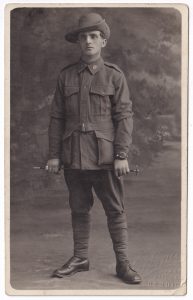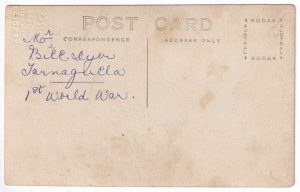[Editor: This postcard incorporates a photo of an Australian soldier, from the era of the First World War (1914-1918). The postcard is undated.]
[Front of postcard]
[Description: Photograph of an Australian soldier.]
[The manufacturer’s details are embossed in the bottom right corner of the postcard:]
Kalma
57 & 59
Pall Mall
Bendigo
[Reverse of postcard]
POST CARD
Kodak Austral
[Handwritten text, in italics]
Mr. Bill Dyer
Tarnagulla
1st World War.
Source:
Original document
Editor’s notes:
Dimensions (approximate): 86 mm. (width), 138 mm. (height).
The soldier shown in this postcard is believed to be William Charles Dyer, of the 38th Australian Infantry Battalion, from Tarnagulla (Victoria).
See: “Private William Charles Dyer”, Australian War Memorial
The manufacturer’s details (Kalma, 57 & 59 Pall Mall, Bendigo), embossed in the bottom right corner of the postcard, are not easy to read (requiring the turning of the postcard to catch the right angle, under a strong light). However, the photographer’s details have been confirmed by references to the Kalma studio in Victorian newspapers. “Kalma” was the business name used by Ernest Wilkinson, a photographer, whose premises were located at 57-59 Pall Mall, Bendigo.
See: 1) “Later particulars”, The Bendigo Independent (Bendigo Vic. ), 24 November 1917, p. 3
2) “Trawool tragedy”, The Argus (Melbourne, Vic..), 22 November 1917, p. 7
The postcard was made on cardboard manufactured by Kodak Australia.
The handwritten text on the reverse of the postcard appears to have been added some years later (i.e. the writing is not contemporaneous with the creation of the postcard).
Austral = of or relating to Australia or Australasia; Australian, Australasian; an abbreviation of Australia, Australian, Australasia, Australasian; in a wider context, of or relating to the southern hemisphere; southern, especially a southern wind
Bill = a diminutive form of “William”; there are several diminutive forms of William: Bill, Billie, Billy, Will, Willie, Wills, Willy, (Scottish) Wullie
Tarnagulla = a town in central Victoria, located west of Bendigo


Leave a Reply